EX2300 Site Guidelines and Requirements
Environmental Requirements and Specifications for EX Series Switches
The switch must be installed in a rack or cabinet housed in a dry, clean, well-ventilated, and temperature-controlled environment.
Ensure that these environmental guidelines are followed:
The site must be as dust-free as possible, because dust can clog air intake vents and filters, reducing the efficiency of the switch cooling system.
Maintain ambient airflow for normal switch operation. If the airflow is blocked or restricted, or if the intake air is too warm, the switch might overheat, leading to the switch temperature monitor shutting down the switch to protect the hardware components.
Table 1 provides the required environmental conditions for normal switch operation.
Switch or device |
Environment Tolerance |
|||
|---|---|---|---|---|
Altitude |
Relative Humidity |
Temperature |
Seismic |
|
|
EX2200-C |
No performance degradation up to 5,000 feet (1524 meters) |
Normal operation ensured in the relative humidity range 10% through 85% (noncondensing) |
Normal operation ensured in the temperature range 32° F (0° C) through 104° F (40° C) at altitudes up to 5,000 ft (1,524 m). For information about extended temperature SFP transceivers supported on EX2200 switches, see Pluggable Transceivers Supported on EX2200 Switches. |
Complies with Zone 4 earthquake requirements as per GR-63, Issue 4. |
|
EX2200 (except EX2200-C switches) |
No performance degradation up to 10,000 feet (3048 meters) |
Normal operation ensured in the relative humidity range 10% through 85% (noncondensing) |
Normal operation ensured in the temperature range 32° F (0° C) through 113° F (45° C) |
Complies with Zone 4 earthquake requirements as per GR-63, Issue 4. |
|
EX2300-C |
No performance degradation up to 5,000 feet (1524 meters) |
Normal operation ensured in the relative humidity range 10% through 85% (noncondensing) |
Normal operation ensured in the temperature range 32° F (0° C) through 104° F (40° C) |
Complies with Zone 4 earthquake requirements as per GR-63, Issue 4. |
|
EX2300 (except EX2300-C switches) |
No performance degradation up to 13,000 feet (3962 meters) at 104° F (40° C) as per GR-63 |
Normal operation ensured in the relative humidity range 10% through 85% (noncondensing) |
Normal operation ensured in the temperature range 32° F (0° C) through 113° F (45° C) |
Complies with Zone 4 earthquake requirements as per GR-63, Issue 4. |
|
EX3200 |
No performance degradation up to 10,000 feet (3048 meters) |
Normal operation ensured in the relative humidity range 10% through 85% (noncondensing) |
Normal operation ensured in the temperature range 32° F (0° C) through 113° F (45° C) |
Complies with Zone 4 earthquake requirements as per GR-63, Issue 4. |
|
EX3300 |
No performance degradation up to 10,000 feet (3048 meters) |
Normal operation ensured in the relative humidity range 10% through 85% (noncondensing) |
Normal operation ensured in the temperature range 32° F (0° C) through 113° F (45° C) |
Complies with Zone 4 earthquake requirements as per GR-63, Issue 4. |
|
EX3400 |
No performance degradation up to 10,000 feet (3048 meters) |
Normal operation ensured in the relative humidity range 10% through 85% (noncondensing) |
Normal operation ensured in the temperature range 32° F (0° C) through 113° F (45° C) |
Complies with Zone 4 earthquake requirements as per GR-63, Issue 4. |
|
EX4100 |
No performance degradation up to 5,000 feet (1524 meters) |
Normal operation ensured in the relative humidity range 10% through 85% (noncondensing) |
Normal operation ensured in the temperature range 32° F (0° C) through 113° F (45° C) |
Complies with Zone 4 earthquake requirements as per GR-63, Issue 4. |
|
EX4200 |
No performance degradation up to 10,000 feet (3048 meters) |
Normal operation ensured in the relative humidity range 10% through 85% (noncondensing) |
Normal operation ensured in the temperature range 32° F (0° C) through 113° F (45° C) |
Complies with Zone 4 earthquake requirements as per GR-63, Issue 4. |
|
EX4300 |
EX4300 switches except the EX4300-48MP model— No performance degradation up to 10,000 feet (3048 meters) EX4300-48MP model— No performance degradation up to 6,000 feet (1829 meters) |
EX4300 switches except the EX4300-48MP model— Normal operation ensured in the relative humidity range 10% through 85% (noncondensing) EX4300-48MP model— Normal operation ensured in the relative humidity range 5% through 90% (noncondensing) |
Normal operation ensured in the temperature range 32° F (0° C) through 113° F (45° C) |
Complies with Zone 4 earthquake requirements as per GR-63, Issue 4. |
|
EX4400 |
No performance degradation up to 6,000 feet (1829 meters) |
Normal operation ensured in the relative humidity range 10% through 90% (noncondensing) |
Normal operation ensured in the temperature range 32° F (0° C) through 113° F (45° C) |
Complies with Zone 4 earthquake requirements as per GR-63, Issue 4. |
|
EX4500 |
No performance degradation up to 10,000 feet (3048 meters) |
Normal operation ensured in the relative humidity range 10% through 85% (noncondensing) |
Normal operation ensured in the temperature range 32° F (0° C) through 113° F (45° C) |
Complies with Zone 4 earthquake requirements as per GR-63, Issue 4. |
|
EX4550 |
No performance degradation up to 10,000 feet (3048 meters) |
Normal operation ensured in the relative humidity range 10% through 85% (noncondensing) |
|
Complies with Zone 4 earthquake requirements as per GR-63, Issue 4. |
|
EX4600 |
No performance degradation to 6,562 feet (2000 meters) |
Normal operation ensured in the relative humidity range 5% through 90%, noncondensing
|
|
Complies with Zone 4 earthquake requirements per NEBS GR-63-CORE, Issue 4. |
|
EX4650 |
No performance degradation to 6,000 feet (1829 meters) |
Normal operation ensured in the relative humidity range 10% through 85% (condensing) |
Normal operation is ensured in the temperature range 32° F (0° C) through 104° F (40° C) |
Complies with Zone 4 earthquake requirements as per GR-63, Issue 4. |
|
EX6210 |
No performance degradation up to 10,000 feet (3048 meters) |
Normal operation ensured in the relative humidity range 10% through 85% (noncondensing) |
Normal operation is ensured in the temperature range 32° F (0° C) through 104° F (40° C) |
Complies with Zone 4 earthquake requirements as per GR-63, Issue 4. |
|
EX8208 |
No performance degradation up to 10,000 feet (3048 meters) |
Normal operation ensured in the relative humidity range 10% through 85% (noncondensing) |
Normal operation is ensured in the temperature range 32° F (0° C) through 104° F (40° C) |
Complies with Zone 4 earthquake requirements as per GR-63, Issue 4. |
|
EX8216 |
No performance degradation up to 10,000 feet (3048 meters) |
Normal operation ensured in the relative humidity range 10% through 85% (noncondensing) |
Normal operation is ensured in the temperature range 32° F (0° C) through 104° F (40° C) |
Complies with Zone 4 earthquake requirements as per GR-63, Issue 4. |
|
EX9204 |
No performance degradation up to 10,000 feet (3048 meters) |
Normal operation ensured in the relative humidity range 5% through 90% (noncondensing) |
Normal operation is ensured in the temperature range 32° F (0° C) through 104° F (40° C) Nonoperating storage temperature in shipping container: – 40° F (–40° C) to 158° F (70° C) |
Complies with Zone 4 earthquake requirements as per GR-63. |
|
EX9208 |
No performance degradation up to 10,000 feet (3048 meters) |
Normal operation ensured in the relative humidity range 5% through 90% (noncondensing) |
Normal operation is ensured in the temperature range 32° F (0° C) through 104° F (40° C) Nonoperating storage temperature in shipping container: – 40° F (–40° C) to 158° F (70° C) |
Complies with Zone 4 earthquake requirements as per GR-63. |
|
EX9214 |
No performance degradation up to 10,000 feet (3048 meters) |
Normal operation ensured in the relative humidity range 5% through 90% (noncondensing) |
Normal operation is ensured in the temperature range 32° F (0° C) through 104° F (40° C) Nonoperating storage temperature in shipping container: – 40° F (–40° C) through 158° F (70° C) |
Complies with Zone 4 earthquake requirements as per GR-63. |
|
EX9251 |
No performance degradation up to 10,000 ft (3048 m) |
Normal operation ensured in relative humidity range of 5% to 90%, noncondensing |
Normal operation ensured in temperature range of 32° F (0° C) to 104° F (40° C) Nonoperating storage temperature in shipping container: – 40° F (–40° C) to 158° F (70° C) |
Complies with Telcordia Technologies Zone 4 earthquake requirements |
|
XRE200 |
No performance degradation up to 10,000 feet (3048 meters) |
Normal operation ensured in the relative humidity range 10% through 85% (noncondensing) |
Normal operation ensured in the temperature range 41° F (5° C) through 104° F (40° C) |
Complies with Zone 4 earthquake requirements as per GR-63, Issue 4. |
Install EX Series switches only in restricted areas, such as dedicated equipment rooms and equipment closets, in accordance with Articles 110– 16, 110– 17, and 110– 18 of the National Electrical Code, ANSI/NFPA 70.
General Site Guidelines
Efficient device operation requires proper site planning. For the device to operate properly, you must ensure maintenance and proper layout of the equipment, rack or cabinet, and wiring closet.
To plan and create an acceptable operating environment for your device and prevent environmentally caused equipment failures:
Keep the area around the chassis free from dust and conductive material, such as metal flakes.
Follow the prescribed airflow guidelines to ensure that the cooling system functions properly. Ensure that the exhaust from other equipment does not blow into the intake vents of the device.
Follow the prescribed electrostatic discharge (ESD) prevention procedures to prevent damaging the equipment. Static discharge can cause components to fail completely or intermittently over time.
Install the device in a secure area, so that only authorized personnel can access the device.
Site Electrical Wiring Guidelines
Table 2 describes the factors you must consider while planning the electrical wiring at your site.
You must provide a properly grounded and shielded environment and use electrical surge-suppression devices.
Avertissement Vous devez établir un environnement protégé et convenablement mis à la terre et utiliser des dispositifs de parasurtension.
|
Site Wiring Factor |
Guidelines |
|---|---|
|
Signaling limitations |
If your site experiences any of the following problems, consult experts in electrical surge suppression and shielding:
|
|
Radio frequency interference |
To reduce or eliminate RFI from your site wiring, do the following:
|
|
Electromagnetic compatibility |
If your site is susceptible to problems with electromagnetic compatibility (EMC), particularly from lightning or radio transmitters, seek expert advice. Strong sources of electromagnetic interference (EMI) can cause:
|
Rack Requirements
You can mount the device on two-post racks or four-post racks.
|
Rack Requirement |
Guidelines |
|---|---|
|
Rack type |
A U is the standard rack unit defined by the Electronic Components Industry Association (ECIA) (http://www.ecianow.org). You can mount the device on a rack that provides bracket holes or hole patterns spaced at 1U (1.75 in. or 4.45 cm) increments and meets the size and strength requirements to support the weight. |
|
Mounting bracket hole spacing |
The holes in the mounting brackets are spaced at 1U (1.75 in. or 4.45 cm) so that the device can be mounted in any rack that provides holes spaced at that distance. |
|
Rack size and strength |
Ensure that the:
|
|
Rack connection to building structure |
|
Cabinet Requirements
You can mount the device in a cabinet that contains a 19-in. rack.
|
Cabinet Requirement |
Guidelines |
|---|---|
|
Cabinet size and clearance |
|
|
Cabinet airflow requirements |
When you mount the device in a cabinet:
|
Requirements for Mounting an EX2300 Switch On or Under a Desk or Other Level Surface or On a Wall
You can mount the switch on a desk or other level surface. You can mount the EX2300-C switch under a desk or other level surface. You can mount EX2300 switches except the EX2300-24MP and EX2300-48MP models on a wall. When choosing a location, allow at least 6 in. (15.2 cm) of clearance between the front and back of the chassis and adjacent equipment or walls.
Ensure that the wall onto which the switch is installed is stable and securely supported.
If you are mounting the switch in sheetrock (wall board with a gypsum plaster core) or in wall board not backed by wall studs, use hollow wall anchors capable of supporting the combined weight of two fully loaded chassis. Insert the screws into wall studs wherever possible to provide added support for the chassis.
Use the wall-mount kit from Juniper Networks to mount the switch on a wall. The wall-mount kit is not part of the standard package and must be ordered separately.
See Also
Clearance Requirements for Airflow and Hardware Maintenance for EX2300 Switches
When planning the site for installing an EX2300 switch, you must allow sufficient clearance around the installed switch. Figure 1 shows the clearance requirements for the EX2300-C switches. Figure 2 shows the clearance requirements for EX2300 switches, except the EX2300-C, EX2300-24MP, and EX2300-48MP switches, with PoE capability. Figure 3 shows the clearance requirements for EX2300-24MP switches. Figure 4 shows the clearance requirements for EX2300-48MP switches.
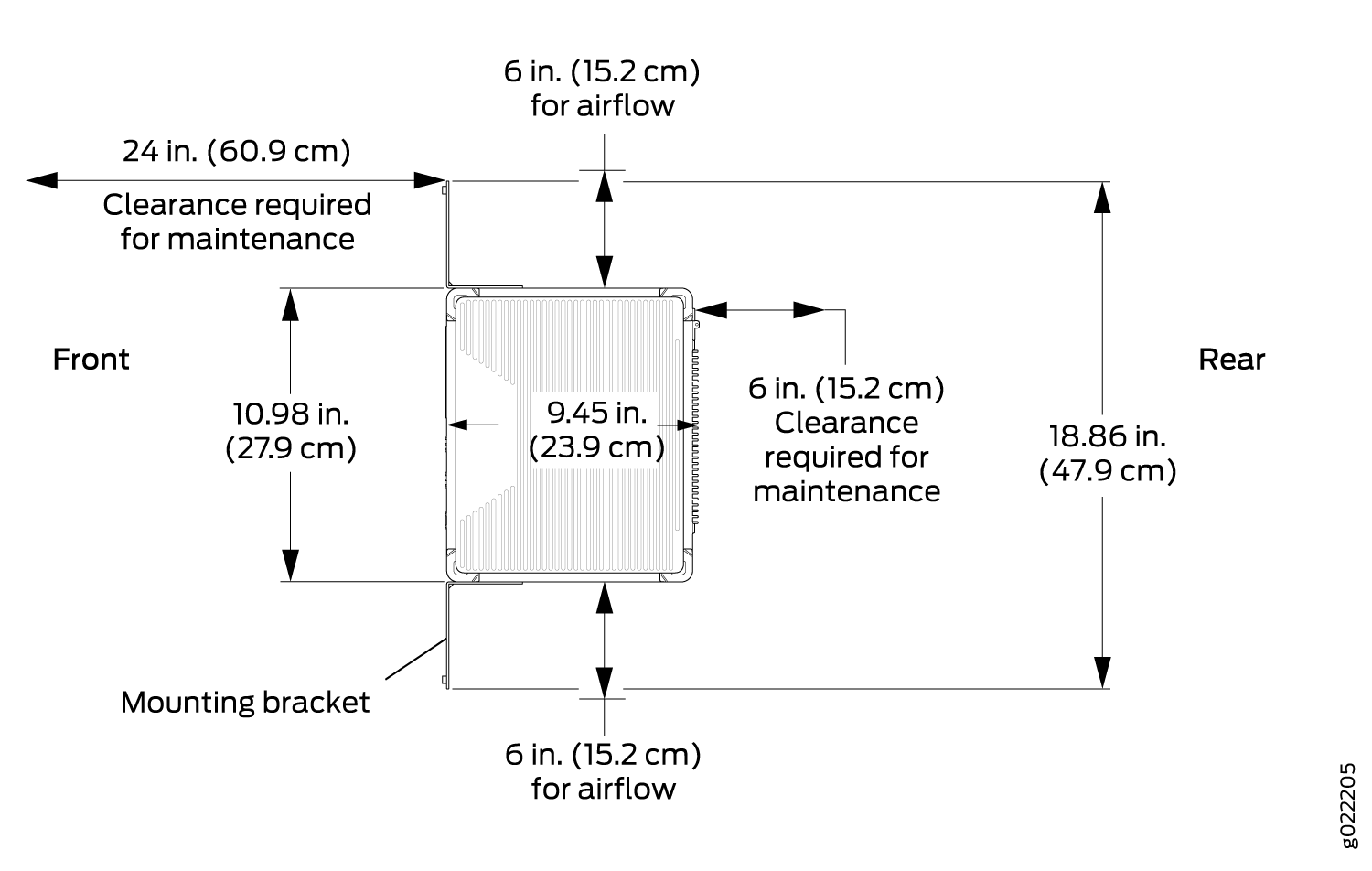
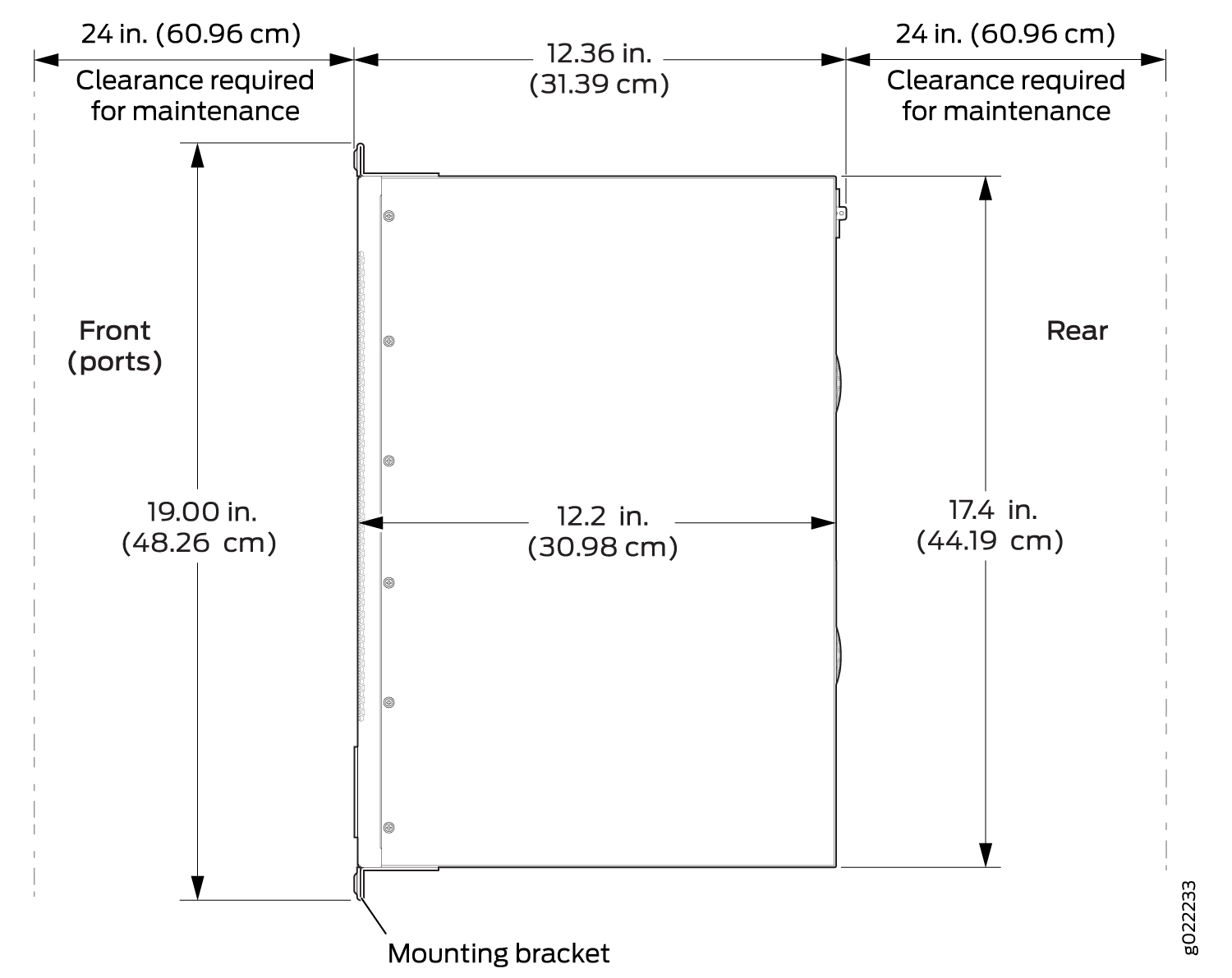
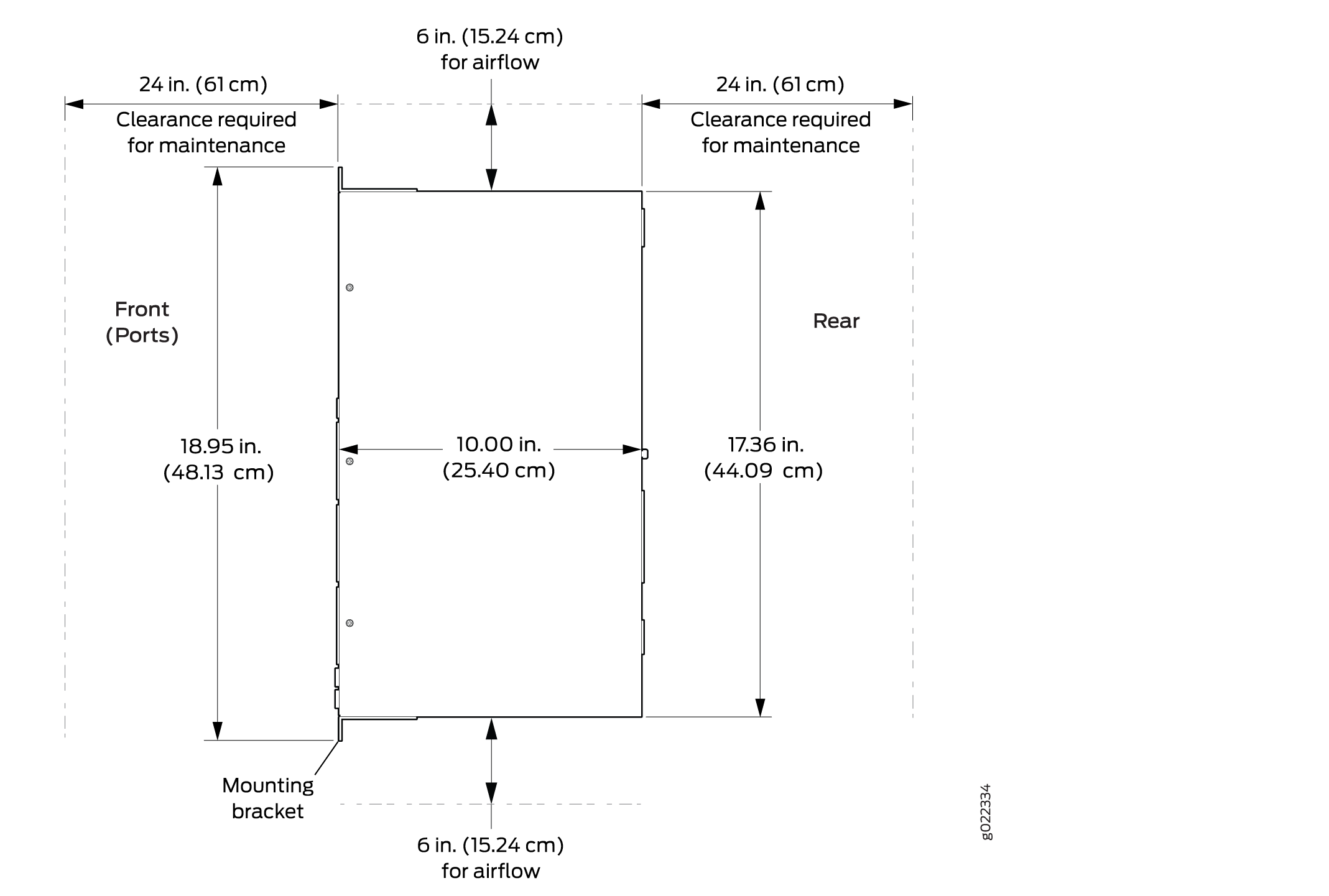
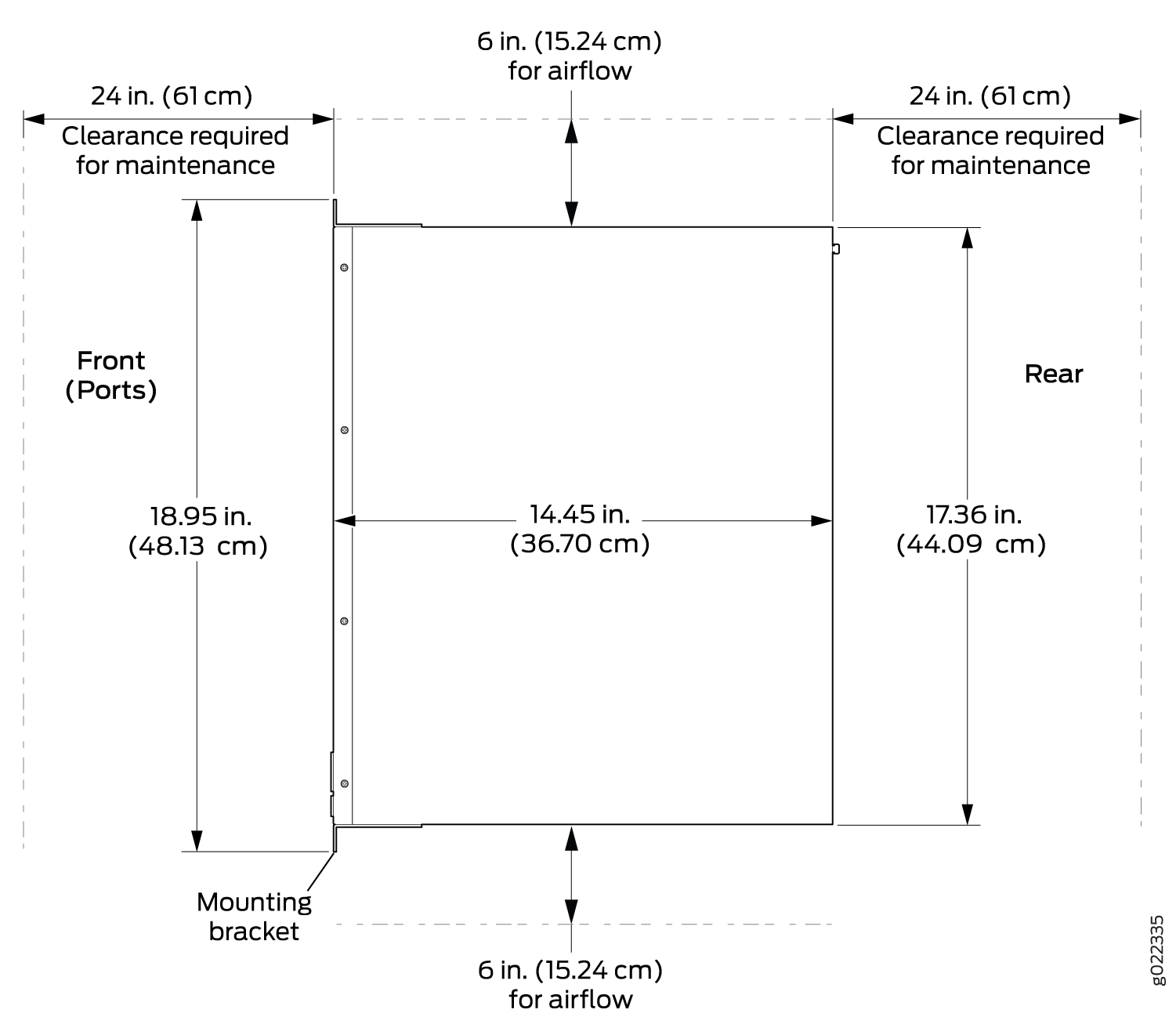
The power cord retainer clips in EX2300 switches except the EX2300-24MP and EX2300-48MP switches extend out of the rear of the chassis by 3 in. (7.6 cm).
-
Allow at least 6 in. (15.2 cm) of clearance on the side between devices that have fans installed. Allow 2.8 in. (7 cm) between the side of the chassis and any non-heat-producing surface such as a wall. For the cooling system to function properly, the airflow around the chassis must be unrestricted.
Figure 5 shows the airflow in EX2300 switches with 24 ports with PoE capability, except the EX2300-24MP switch. Figure 6 shows the airflow in EX2300-24MP switch. Figure 7 shows the airflow in EX2300 switches with 48 ports with PoE capability, except the EX2300-48MP switch. Figure 8 shows the airflow in EX2300-48MP switch. Figure 9 shows the airflow in EX2300 switches without PoE capability.
Figure 5: Airflow Direction in EX2300 Switches with 24 Ports with PoE Capability Except the EX2300-24MP Switch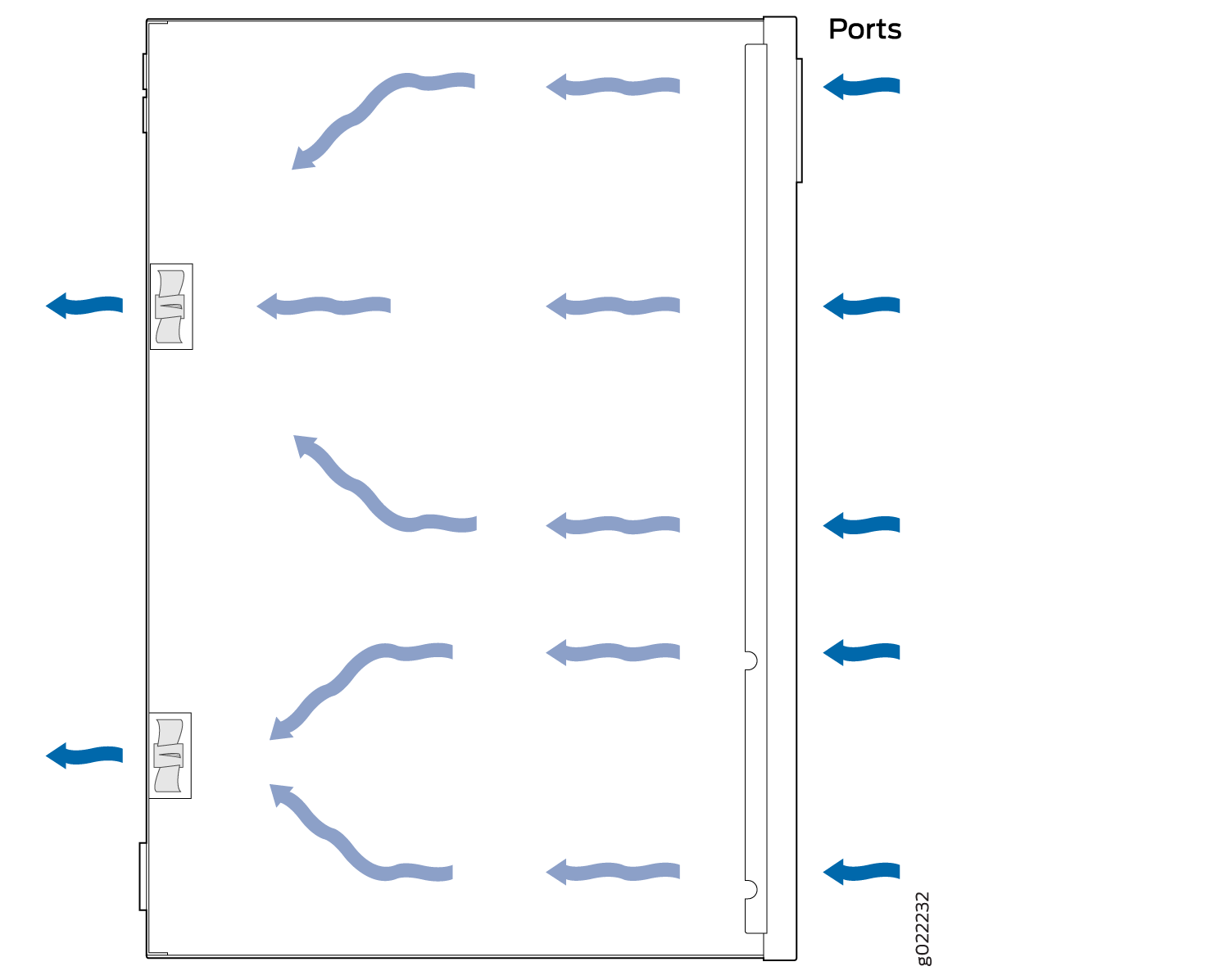 Figure 6: Airflow Direction in EX2300-24MP Switches
Figure 6: Airflow Direction in EX2300-24MP Switches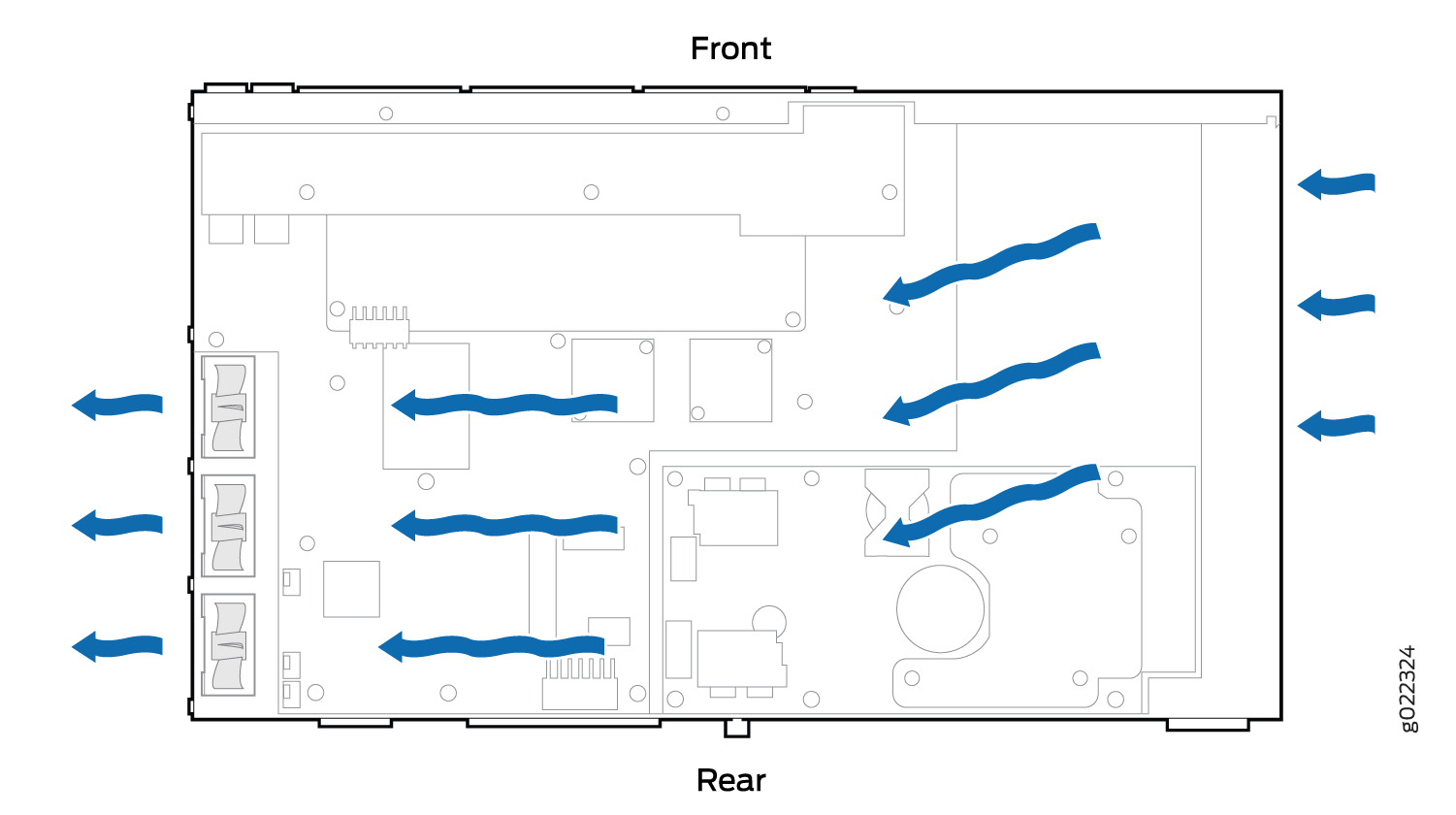 Figure 7: Airflow Direction in EX2300 Switches with 48 Ports with PoE Capability Except the EX2300-48MP Switch
Figure 7: Airflow Direction in EX2300 Switches with 48 Ports with PoE Capability Except the EX2300-48MP Switch Figure 8: Airflow Direction in EX2300-48MP Switches
Figure 8: Airflow Direction in EX2300-48MP Switches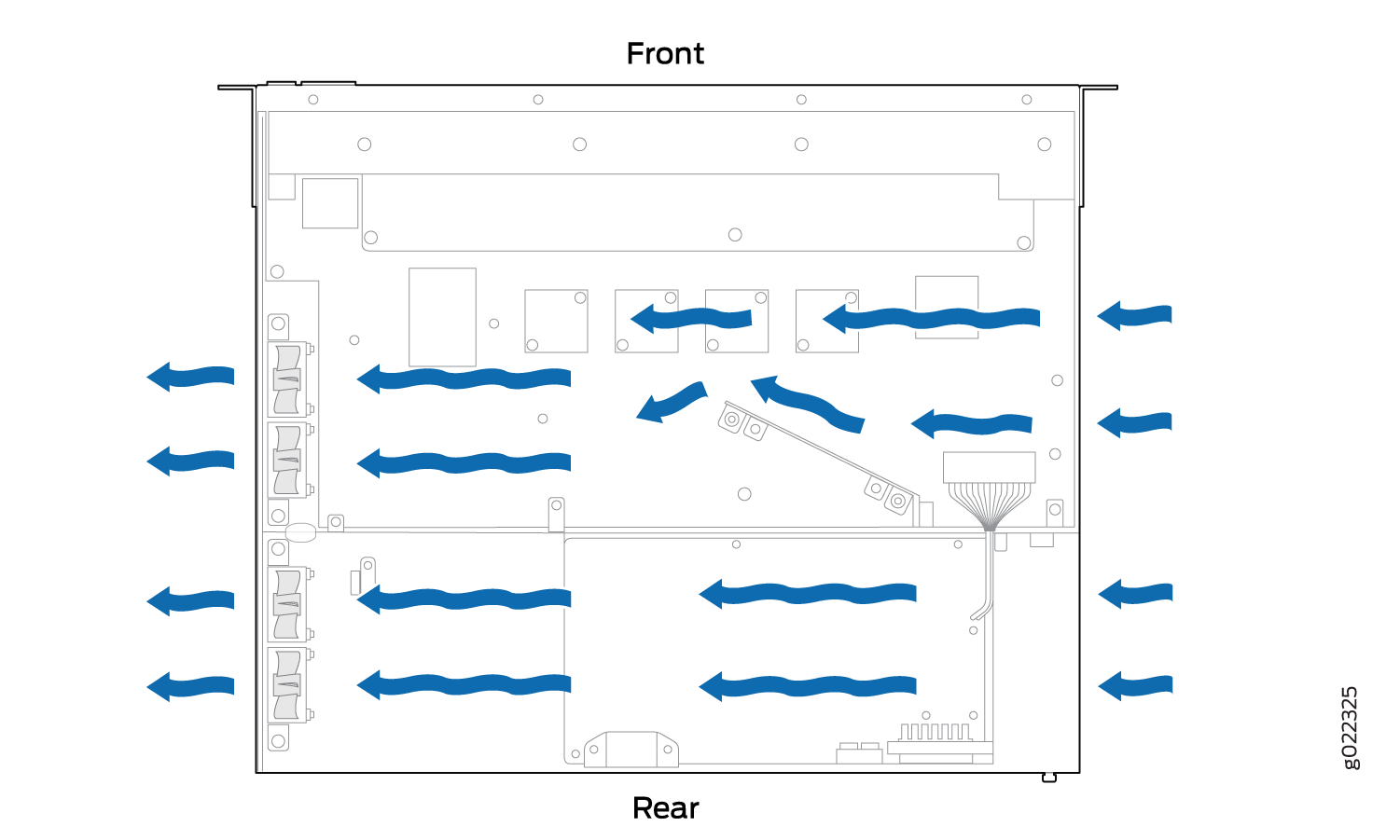 Figure 9: Airflow Direction in EX2300 Switches without PoE Capability
Figure 9: Airflow Direction in EX2300 Switches without PoE Capability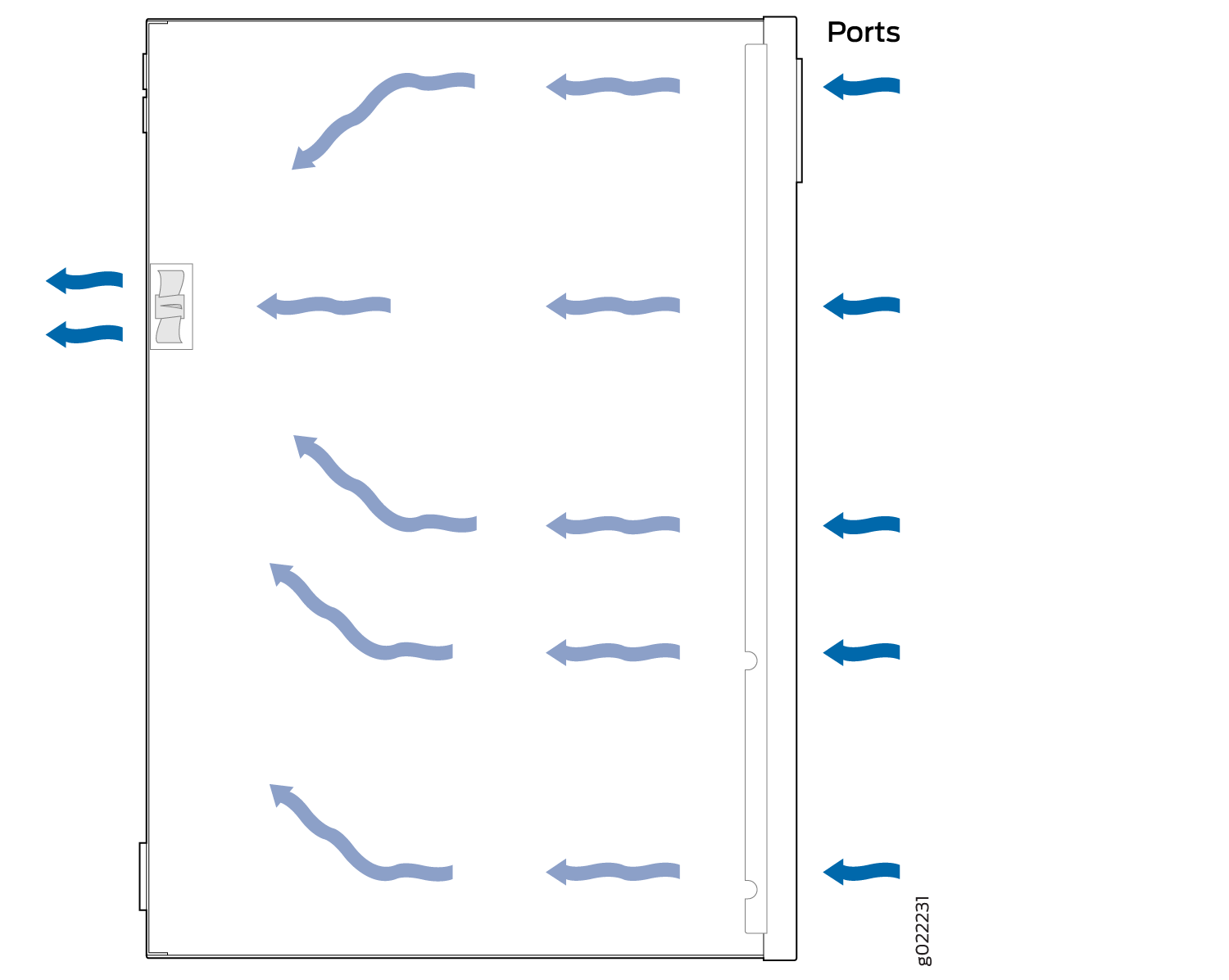
-
If you are mounting an EX2300 switch in a rack or cabinet with other equipment, or if you are placing it on or under a desk or floor near other equipment, ensure that the exhaust from other equipment does not blow into the intake vents of the chassis.
Note:You can mount only EX2300-C switches under a desk or other level surface.
-
Leave at least 24 in. (61 cm) in front of the switch and 6 in. (15.2 cm) behind the switch. For service personnel to remove and install hardware components, you must leave adequate space at the front and back of the switch. NEBS GR-63 recommends that you allow at least 30 in. (76.2 cm) in front of the rack or cabinet and 24 in. (61 cm) behind the rack or cabinet.
